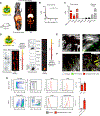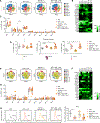Trained Immunity-Promoting Nanobiologic Therapy Suppresses Tumor Growth and Potentiates Checkpoint Inhibition
- PMID: 33125893
- PMCID: PMC8074872
- DOI: 10.1016/j.cell.2020.09.059
Trained Immunity-Promoting Nanobiologic Therapy Suppresses Tumor Growth and Potentiates Checkpoint Inhibition
Abstract
Trained immunity, a functional state of myeloid cells, has been proposed as a compelling immune-oncological target. Its efficient induction requires direct engagement of myeloid progenitors in the bone marrow. For this purpose, we developed a bone marrow-avid nanobiologic platform designed specifically to induce trained immunity. We established the potent anti-tumor capabilities of our lead candidate MTP10-HDL in a B16F10 mouse melanoma model. These anti-tumor effects result from trained immunity-induced myelopoiesis caused by epigenetic rewiring of multipotent progenitors in the bone marrow, which overcomes the immunosuppressive tumor microenvironment. Furthermore, MTP10-HDL nanotherapy potentiates checkpoint inhibition in this melanoma model refractory to anti-PD-1 and anti-CTLA-4 therapy. Finally, we determined MTP10-HDL's favorable biodistribution and safety profile in non-human primates. In conclusion, we show that rationally designed nanobiologics can promote trained immunity and elicit a durable anti-tumor response either as a monotherapy or in combination with checkpoint inhibitor drugs.
Keywords: cancer; checkpoint inhibitors; immunotherapy; innate immunity; melanoma; myeloid cells; nanobiologics; nanomedicine; nanotechnology; trained immunity.
Copyright © 2020 Elsevier Inc. All rights reserved.
Conflict of interest statement
Declaration of Interests W.J.M.M., L.A.B.J., J.O., Z.A.F., and M.G.N. are scientific co-founders of and have equity in Trained Therapeutix Discovery. W.J.M.M. and Z.A.F. have consulting agreements with Trained Therapeutix Discovery.
Figures







Comment in
-
Nanobiologic trains innate immunity for anticancer responses.Nat Rev Immunol. 2020 Dec;20(12):718-719. doi: 10.1038/s41577-020-00476-w. Nat Rev Immunol. 2020. PMID: 33173162 No abstract available.
Similar articles
-
In situ immunogenic clearance induced by a combination of photodynamic therapy and rho-kinase inhibition sensitizes immune checkpoint blockade response to elicit systemic antitumor immunity against intraocular melanoma and its metastasis.J Immunother Cancer. 2021 Jan;9(1):e001481. doi: 10.1136/jitc-2020-001481. J Immunother Cancer. 2021. PMID: 33479026 Free PMC article.
-
Cancer Cell Membrane Camouflaged Mesoporous Silica Nanoparticles Combined with Immune Checkpoint Blockade for Regulating Tumor Microenvironment and Enhancing Antitumor Therapy.Int J Nanomedicine. 2021 Mar 12;16:2107-2121. doi: 10.2147/IJN.S295565. eCollection 2021. Int J Nanomedicine. 2021. PMID: 33737808 Free PMC article.
-
Targeting the vascular endothelial growth factor receptor-1 by the monoclonal antibody D16F7 to increase the activity of immune checkpoint inhibitors against cutaneous melanoma.Pharmacol Res. 2020 Sep;159:104957. doi: 10.1016/j.phrs.2020.104957. Epub 2020 May 30. Pharmacol Res. 2020. PMID: 32485280
-
Therapeutic Approaches Targeting the Natural Killer-Myeloid Cell Axis in the Tumor Microenvironment.Front Immunol. 2021 Apr 19;12:633685. doi: 10.3389/fimmu.2021.633685. eCollection 2021. Front Immunol. 2021. PMID: 33953710 Free PMC article. Review.
-
Augmenting Anticancer Immunity Through Combined Targeting of Angiogenic and PD-1/PD-L1 Pathways: Challenges and Opportunities.Front Immunol. 2020 Nov 5;11:598877. doi: 10.3389/fimmu.2020.598877. eCollection 2020. Front Immunol. 2020. PMID: 33250900 Free PMC article. Review.
Cited by
-
Tissue-Resident and Recruited Macrophages in Primary Tumor and Metastatic Microenvironments: Potential Targets in Cancer Therapy.Cells. 2021 Apr 20;10(4):960. doi: 10.3390/cells10040960. Cells. 2021. PMID: 33924237 Free PMC article. Review.
-
Nuclear RNA catabolism controls endogenous retroviruses, gene expression asymmetry, and dedifferentiation.Mol Cell. 2023 Dec 7;83(23):4255-4271.e9. doi: 10.1016/j.molcel.2023.10.036. Epub 2023 Nov 22. Mol Cell. 2023. PMID: 37995687 Free PMC article.
-
Nonresolving inflammation redux.Immunity. 2022 Apr 12;55(4):592-605. doi: 10.1016/j.immuni.2022.03.016. Immunity. 2022. PMID: 35417674 Free PMC article. Review.
-
Targeted Anti-Tumor Immunotherapy Using Tumor Infiltrating Cells.Adv Sci (Weinh). 2021 Nov;8(22):e2101672. doi: 10.1002/advs.202101672. Epub 2021 Oct 18. Adv Sci (Weinh). 2021. PMID: 34658167 Free PMC article. Review.
-
Targeted modulation of immune cells and tissues using engineered biomaterials.Nat Rev Bioeng. 2023 Feb;1(2):107-124. doi: 10.1038/s44222-022-00016-2. Epub 2023 Jan 30. Nat Rev Bioeng. 2023. PMID: 37772035 Free PMC article.
References
Publication types
MeSH terms
Substances
Grants and funding
- R01 CA244780/CA/NCI NIH HHS/United States
- R01 HL144072/HL/NHLBI NIH HHS/United States
- F32 CA247414/CA/NCI NIH HHS/United States
- P01 HL131478/HL/NHLBI NIH HHS/United States
- P30 CA008748/CA/NCI NIH HHS/United States
- R01 AI139623/AI/NIAID NIH HHS/United States
- R01 HL143814/HL/NHLBI NIH HHS/United States
- R01 DA049547/DA/NIDA NIH HHS/United States
- R01 CA220234/CA/NCI NIH HHS/United States
- P30 CA196521/CA/NCI NIH HHS/United States
- K22 CA226040/CA/NCI NIH HHS/United States
- T32 CA078207/CA/NCI NIH HHS/United States
- K22 CA196750/CA/NCI NIH HHS/United States
LinkOut - more resources
Full Text Sources
Other Literature Sources

